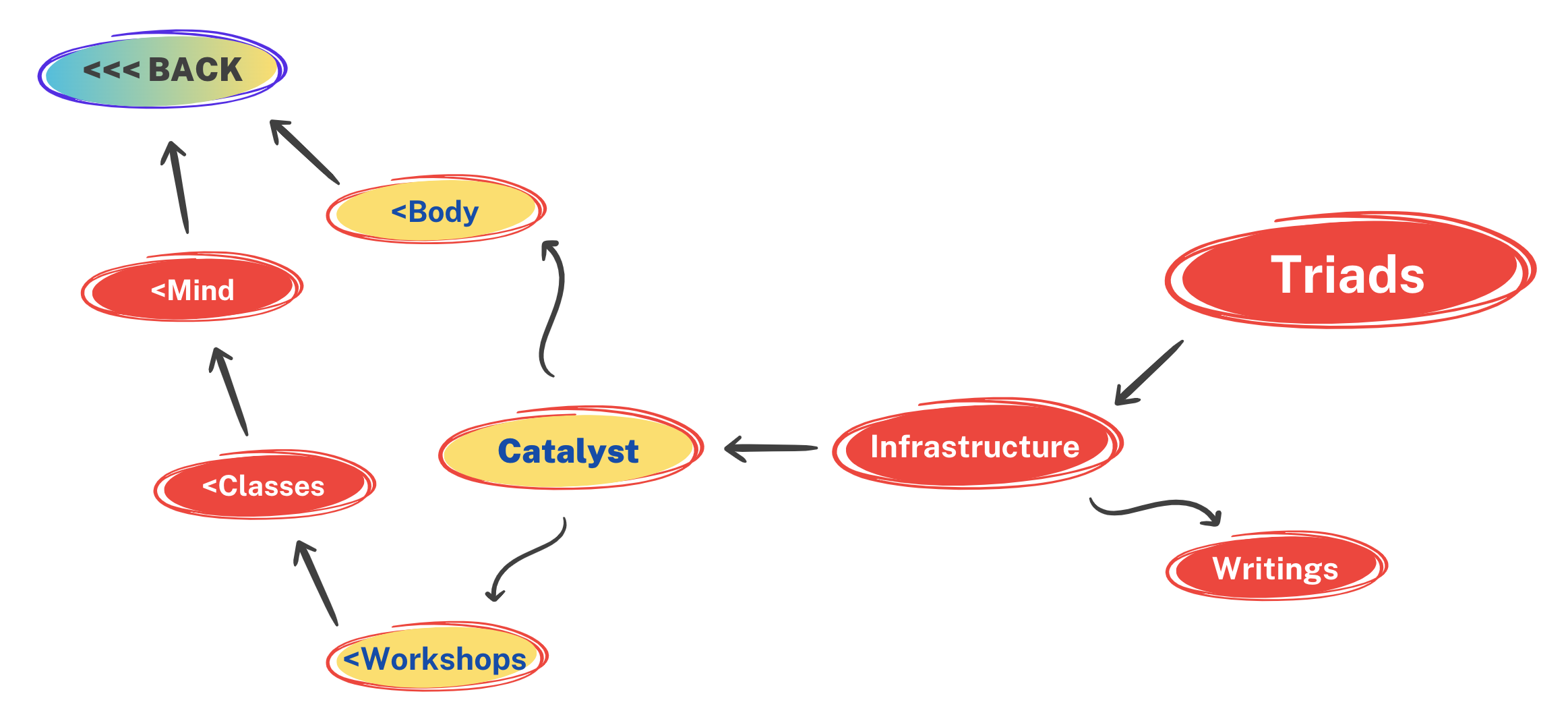
CATALYST TRIADS
Triads are groupings of three. Catalyst has many triads. It began with the understanding that people are made up of mind, body, and soul. This is the main triad in Catalyst, which is named Red, Yellow, and Blue respectively. The mental, physical, and spiritual (non-linear) components make up our wholeness. At any time, a person can be more mental, physical, or spiritual, though certain dominances appear more often than others. The body can also presents itself differently, meaning at times it may be more receptive and responsive to certain approaches over others.
Each session consists of three phases: Intention, Initiation, & Integration. Without going into too much detail, intention also has a triad, which includes a participant's intention, the facilitator's intention, and the intention of Catalyst itself, "to enhance function." Combining those three intentions completes that first phase of a session and brings us into the initiation, the delivery of the session itself. This involves "contacts," physical touches onto a participant's body. The initiation phase acts more like a rite of passage, since the mind and body gain new insights at this time of the session. Lastly, sessions conclude with the integration phase, which helps the participant's mind and body to assimilate the benefits on an on-going basis.
Even the benefits of Catalyst have a triad. First and foremost, Catalyst sessions encourage stopping, which is absolutely essential for enhancing functionality. The other two benefits involve enhancing awareness (the sensory system) and enhancing body dynamics (the motor system). Similar to Active Stopping, where stopping is for the sake of stopping, awareness, and answering the call, Catalyst provides all three benefits.
Regarding locations on a participant's body, three main areas are noted. The Area of Influence is the access point, the area on the body that a facilitator contacts (touches). This is the area that allows easy entry of Catalyst into the body. The Area of Manifestation is the area that acts as a parameter to monitor for positive changes. The Area of Engagement completes this triad. This is the location on the body away from the contact that responds most noticeably, as if that part of the body is saying, "I'll take that contact."
Catalyst also has three state-dependent approaches. Simply called Type 1, Type 2, and Type 3, each distinctively different approach correlates to one of the three objectives. Type 1 is Responsive Care. This is for releasing, unwinding, and dissipating tension. Type 2, the default approach, is Proactive Care. This is for conditioning the body to function better. Type 3 is Integrative Care. This is for the mind-body connection and encouraging a greater relationship between the participant and the body. In addition to those three state-dependent approaches, Catalyst has one state-independent approach. Known as Type 4 (Blue), it is "energy work," which in Catalyst means working with resonance.
Even the three state-dependent approaches have a triad regarding how to proceed. Catalyst uses a system known as, "Assess, Address, & Educate." This specific method of inquiry occurs throughout the session to help facilitators be more present and of maximum benefit. Assessing involves gaining information through visual obesrvation, scanning through touch, and feeling of resonance. Addressing is the actual delivery of Catalyst onto the body. Educating involves sharing valuable information for integration. Facilitators provide feedback on what happened, what a participant can do to maximize benefits, and what happens next.
Lastly, participants of Catalyst have an arc for receiving the work, a unique triad that reflects where they are in care. They begin receiving Catalyst with foundational care. Over time, they begin getting developmental care. Lastly, they qualify for receiving advanced work, known as transcendent care. Although the sessions looks similar, the differences are seen in the participant's arc, the growth they integrate. Like building a home, you lay down the foundation. You then move onto building the framework. Finally, you reach a point where you can begin to add all of the finshing touches and fine details.
List of Catalyst Techniques ... Catalyst Writings
Back to Catalyst ... Catalyst Sessions ... Catalyst Classes
The Launch ... Blue Night ... Back to Workshops ... Back to Body
. Back to Classes ... Back to Mind ... Back to Thriveapeutics Main Page